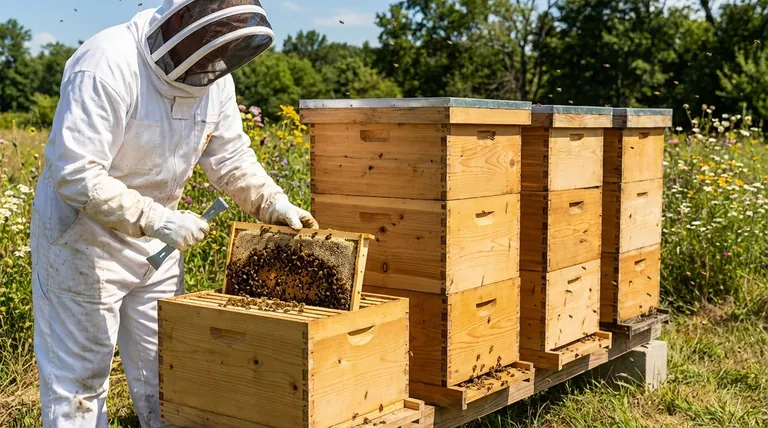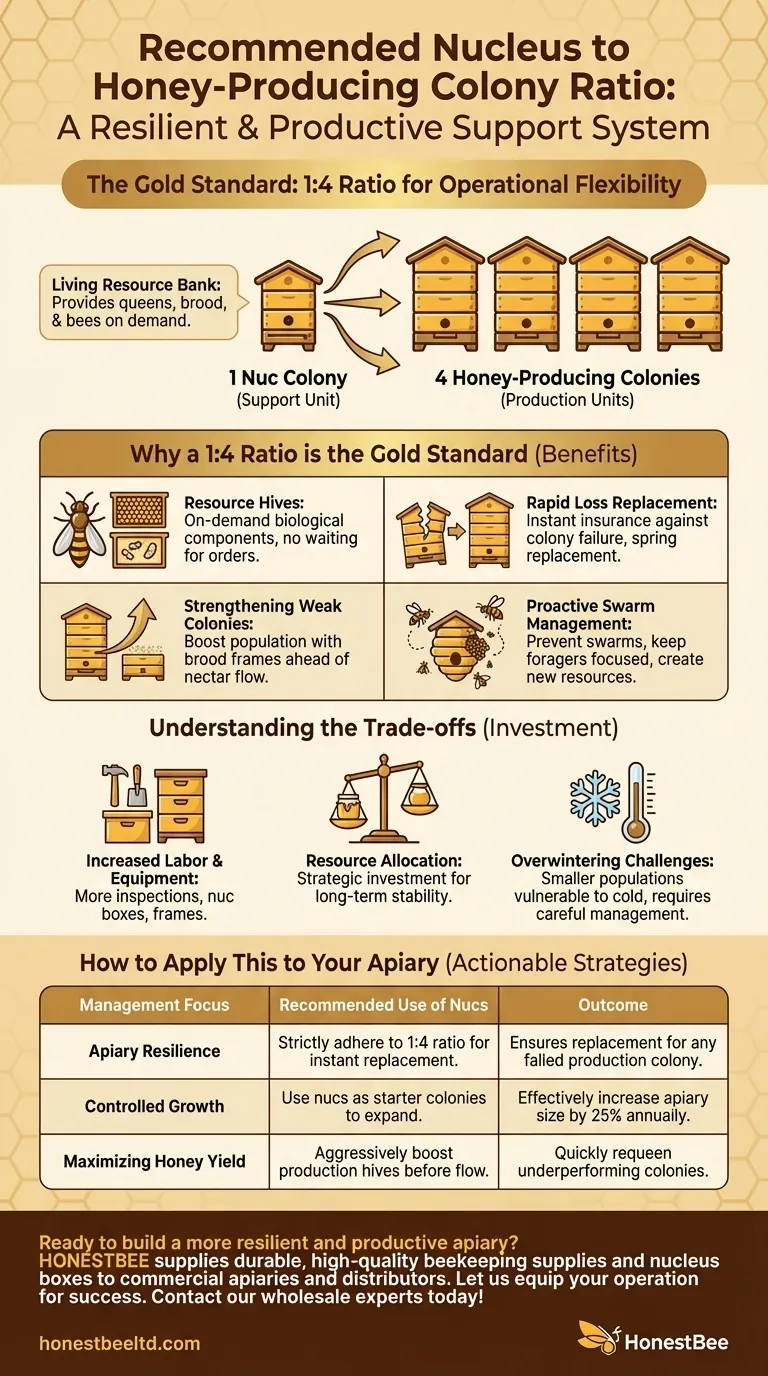For a resilient and productive apiary, the recommended management system includes maintaining one nucleus colony for every four honey-producing colonies. This 1:4 ratio provides the operational flexibility needed to manage hive strength, replace losses, and respond effectively to changing conditions throughout the season.
The core principle is not about a rigid number, but about creating a support system. Nucleus colonies, or "nucs," function as a living resource bank, providing queens, brood, and bees to strengthen your main colonies and ensure the long-term health of your entire operation.

Why a 1:4 Ratio is the Gold Standard
Adopting a nuc-based support system fundamentally changes your beekeeping from a reactive to a proactive discipline. Instead of purchasing replacements for failed colonies, you create them from your own proven and adapted stock.
The Concept of 'Resource Hives'
Think of nucs not as miniature honey producers, but as dedicated support units. Their primary job is to provide biological materials—bees, brood, and queens—on demand.
This system ensures you always have the components you need to solve common beekeeping problems without having to order packages or queens and wait for their arrival.
Rapid Loss Replacement
The most direct benefit is insurance against colony loss. If a full-sized production hive fails during winter or becomes non-viable, a healthy overwintered nuc can be transferred into the full-sized equipment.
This allows you to replace the colony instantly in the spring, preventing a total loss of production from that hive for the entire season.
Strengthening Weak Colonies
A common challenge is a production colony that is slow to build up in the spring. A frame of capped brood from a strong nuc can "boost" this weaker hive, dramatically increasing its population and foraging workforce just ahead of the main nectar flow.
Proactive Swarm Management
When a production hive becomes crowded and prepares to swarm, you can intervene by pulling a frame or two of brood along with the old queen to create a new nuc.
This relieves congestion in the production hive, preventing the swarm and keeping the valuable forager bees focused on honey production. Meanwhile, you have created another resource hive and can introduce a new queen to the production colony.
Understanding the Trade-offs
While highly effective, this management system requires a shift in mindset and resources. It is not a passive strategy.
Increased Labor and Equipment
Maintaining nucs means more hives to inspect and manage. It also requires an investment in additional equipment, specifically nuc boxes, lids, and frames.
Resource Allocation
You are intentionally diverting a small portion of bees and brood that could have contributed to your immediate honey crop.
This should be viewed as a strategic investment. Sacrificing a small amount of short-term production ensures the long-term stability and productivity of the entire apiary.
Overwintering Challenges
Nucs have a smaller population and fewer resources, making them more vulnerable to cold than a full-sized colony. Successfully overwintering nucs requires careful management of food stores, ventilation, and hive placement.
How to Apply This to Your Apiary
Integrating this strategy depends entirely on your operational goals. The 1:4 ratio provides a flexible framework that can be adapted to different priorities.
- If your primary focus is apiary resilience: Strictly adhere to the 1:4 ratio to ensure you always have a replacement on hand for any production colony that fails.
- If your primary focus is controlled growth: Use your nucs as starter colonies, allowing them to expand into full-sized production hives by the end of the season, effectively increasing your apiary size by 25% annually.
- If your primary focus is maximizing honey yield: Use your nucs aggressively to boost the populations of your production hives just before the main nectar flow, and to quickly requeen any underperforming colonies.
By treating nucleus colonies as a strategic asset, you shift from simply keeping bees to actively managing a robust and sustainable apiary.
Summary Table:
| Management Focus | Recommended Use of Nucs |
|---|---|
| Apiary Resilience | Strictly adhere to the 1:4 ratio for instant colony replacement. |
| Controlled Growth | Use nucs as starter colonies to expand your apiary size by 25% annually. |
| Maximizing Honey Yield | Aggressively boost production hive populations before the main nectar flow. |
Ready to build a more resilient and productive apiary? A proactive management system starts with reliable equipment. HONESTBEE supplies durable, high-quality beekeeping supplies and nucleus boxes to commercial apiaries and distributors. Let us equip your operation for success. Contact our wholesale experts today to discuss your needs!
Visual Guide

Related Products
- HONESTBEE Advanced Ergonomic Stainless Steel Hive Tool for Beekeeping
- HONESTBEE Professional Long Handled Hive Tool with Precision Cutting Blade
- HONESTBEE Professional Multi-Functional Hive Tool with Ergonomic Wood Handle
- Professional Dual-End Stainless Steel Hive Tool for Beekeeping
- 5 Frame Langstroth Poly Nuc Corrugated Plastic Nuc Boxes
People Also Ask
- What is the hole in a hive tool for? A Multi-Tool for Apiary Repairs and Maintenance
- What is a hive tool and what are its uses? Master Your Hive Inspections with the Essential Beekeeper's Tool
- Why is it important to compare the progress of different hives? A Beekeeper's Key Diagnostic Tool
- What tools are used for cleaning frames? A Beekeeper's Simple 4-Tool Guide
- Why do hive tools have a hole? Unlock the Secret to Efficient Beekeeping



















